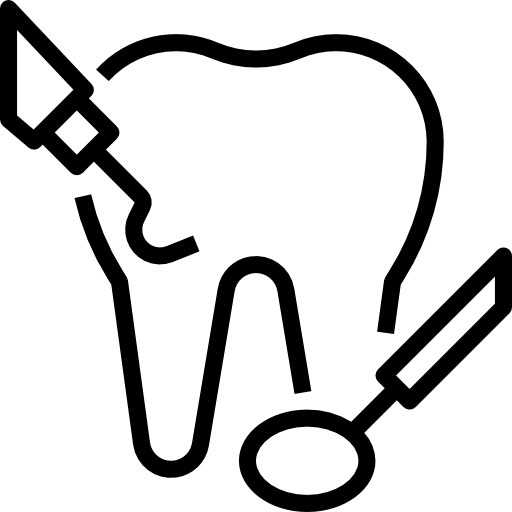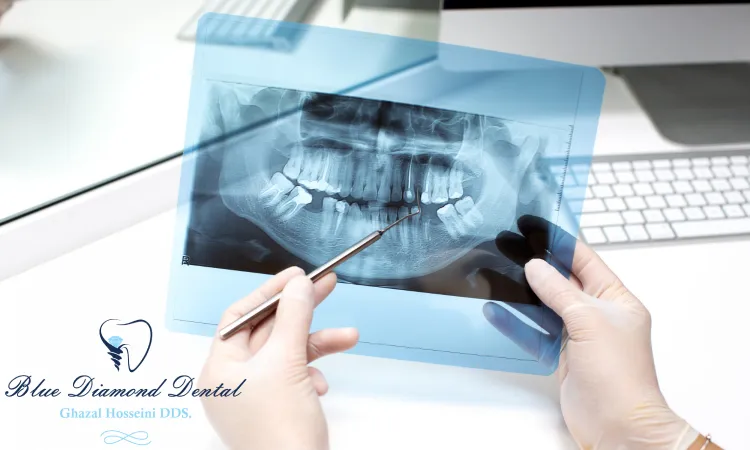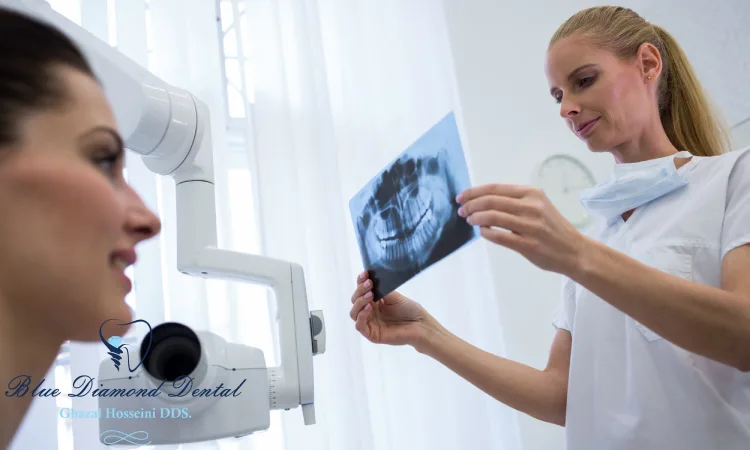- Home
- Services in Blue Diamond Dental

Orthodontics

Pediatric Dentistry
Dental Space Maintainers
Fluoride Treatment
Dental Pulp Treatment
Dental Sealants
Dental Fillings

Cleaning & Prevention

Surgical Dentistry
Tooth extraction
Tooth Extraction Membrane Fell Out
Surgical Placement
Dental bone graft - Contact Us
- About Us
Dental exam & x-rays
When it comes to comprehensive dental care, a full mouth x-ray and exam are essential tools for gaining a thorough understanding of your oral health. The full mouth x-ray allows the dentist to visualize all the teeth, roots, and surrounding bone structures in one image. This comprehensive view is crucial for detecting issues such as hidden cavities, impacted teeth, or jaw bone abnormalities that might not be visible during a regular dental exam.
In addition to the visual information provided by the full mouth x-ray, a complete dental exam involves checking for signs of gum disease, oral cancer, and other oral health concerns. By combining these diagnostic tools with a thorough physical examination of the teeth and soft tissues in the mouth, dentists can create personalized treatment plans tailored to each patient’s specific needs. This proactive approach not only ensures early detection and prevention of potential problems but also allows for more effective long-term oral health management.

By investing in a full mouth x-ray and exam as part of your routine dental care regimen, you’re taking an active role in preserving your overall well-being. Whether you’re seeking preventative care or addressing existing concerns, incorporating these comprehensive assessments into your dental routine can help you achieve optimal oral health while providing valuable insights for maintaining beautiful smiles for years to come.
How often do you need full mouth dental x-rays?
While the frequency of full mouth X-rays can vary depending on individual needs, it is generally recommended to have them every three to five years for most adults. However, for those with a history of extensive dental work or ongoing dental issues, more frequent X-rays may be necessary to monitor changes and prevent potential problems.

It’s important to note that regular check-ups and exams play a crucial role in determining the need for full mouth X-rays. Dentists use these X-rays to identify hidden dental issues such as cavities, gum disease, impacted teeth, and structural abnormalities that may not be visible during a visual exam. By having full mouth X-rays at the recommended intervals, individuals can ensure that any potential problems are detected early on and receive timely treatment. Ultimately, while the frequency of full mouth X-rays may vary from person to person, they are an invaluable tool in maintaining good oral health and preventing serious dental issues down the road.
How long do full mouth dental x-rays take?
Full mouth dental x-rays, also known as a full mouth series or panoramic x-rays, typically take around 15 to 20 minutes to complete. The exact duration can vary depending on the equipment used and the patient’s cooperation. The process involves positioning the patient’s head in a specific way to capture images of all the teeth, roots, jawbone, and surrounding structures.
This comprehensive set of x-rays provides a detailed view of the entire oral cavity, allowing dentists to assess overall dental health more effectively.
During a full mouth x-ray exam, patients may be required to bite down on specially designed film holders or sensors while different angles are captured by the machine.
These images help dentists identify potential issues such as cavities, infections, impacted teeth, and bone abnormalities. Additionally, full mouth dental x-rays are crucial for monitoring changes over time and planning for various treatments like orthodontic procedures or oral surgery. While it may seem cumbersome at first glance, this thorough examination is essential for maintaining optimal oral health and preventing potential complications down the road.
Why are Full mouth dental x-rays important?
Unlike traditional intraoral X-rays that focus on specific areas of the mouth, full mouth X-rays provide a detailed view of the entire oral cavity, including the teeth, jaws, and surrounding structures. This holistic perspective allows dentists to identify hidden issues such as impacted wisdom teeth, cysts, tumors, or bone abnormalities that may not be visible during a regular clinical examination.
Moreover, full mouth dental X-rays are essential for establishing baseline data and tracking changes over time. By comparing previous and current images, dentists can detect signs of decay or periodontal disease early on and intervene with appropriate treatment. Additionally, these X-rays reveal the position of existing restorations and aid in planning necessary interventions such as orthodontic treatments or dental implants. By providing a comprehensive understanding of the patient’s oral health status and potential concerns lurking beneath the surface, full mouth X-rays empower dentists to deliver personalized care tailored to each individual’s needs.

In conclusion,
incorporating full mouth dental X-rays into routine exams offers patients peace of mind knowing that their oral health is thoroughly assessed. While some may express reservations about radiation exposure from these imaging procedures,
it’s important to note that modern digital technology has significantly reduced radiation levels compared to older film-based systems. By embracing this advanced diagnostic tool,
patients can take proactive steps towards maintaining optimal oral health while allowing dentists to provide more precise and effective treatments.

